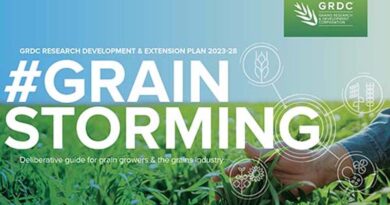GRDC Launches Industry-driven Research Consortium to Capitalise on Growing Global Oat Market
18 April 2024, AU: In a move to boost Australia’s position as a high-quality, value-added oat producer, the launch of a new research-focused Oat Grain Quality Consortium (OGQC) marks a pivotal moment for the industry.
Designed to capitalise on growing domestic and international market opportunities, the consortium is a collaborative Grains Research and Development Corporation (GRDC) investment aimed at addressing the crucial need for innovation in oat quality research, informing oat quality classification and market positioning.
GRDC Managing Director Nigel Hart announced the consortium in Perth today (18 April) which will see more than $12.5 million invested in oats over five years as part of this collaborative research initiative. The investment includes $5.75m from GRDC complemented by $6.7m from research and industry partners.
The consortium will be led by InterGrain and the South Australian Research and Development Institute (SARDI: the research division of the Department of Primary Industries and Regions SA). These lead organisations will bring together a diverse group of organisations spanning the research, production, processing, and food and beverage manufacturing sectors, each contributing their expertise to drive industry transformation.
Partners include Curtin University, Murdoch University, Edith Cowan University, Agriculture Victoria, Shaanxi Normal University, plus industry partners Unigrain, Wide Open Agriculture, Fancy Plants, Oatly, Sanitarium, Uncle Toby’s, Blue Lake Milling, Quaker, Noumi, Seamild, Grains Australia and Australian Export Grains Innovation Centre (AEGIC).
“We know that the global demand for diverse and nutritious oat-based products is on the rise and there is a clear opportunity for Australian agriculture to lead the way in quality and sustainability. This is why GRDC has initiated and invested in this consortium on behalf of Australian growers,” Mr Hart says.
“This research will benefit the entire Australian oat supply chain by providing breeders with new traits that align with market demands, improving efficiency and reducing costs for processors, and expanding the range of oat-based products that manufacturers can offer consumers globally.
“Ultimately this work aims to position Australian oats as the go-to-product for consumers, both domestically and overseas, which will have significant flow-on benefits for our growers.”
The OGQC aims to capitalise on international demand in oats for food and beverage applications via targeted pre-breeding through three programs of activity, each supporting Australian oat pre-breeding research to understand key oat quality traits.
Researchers will work with oat millers and food and beverage processors to develop industry-relevant thresholds for traits such as flavour and aroma, groat oil, beta-glucan and protein, and work with breeding programs to identify and provide germplasm and molecular tools to rapidly develop new oat varieties suited to high-value, end-use market requirements.
GRDC Genetic Technologies Manager (Barley, Oats and Sorghum) Dr Michael Groszmann says for the investment to succeed, it was critical to have engagement from the post-farmgate sector.
“Pleasingly we already have a high level of direct project involvement from both millers and oat food and beverage manufacturers,” Dr Groszmann says.
“By innovating across breeding, measurement, quality and nutritional content through this research, GRDC can help the industry set new standards that drive value-added opportunities for milling oats.”
InterGrain’s Research and Business Development Manager Dr Dini Ganesalingam, says the initiative would use the scale of InterGrain’s oat breeding program to create tools that would aid in quantifying oat quality traits for industry classification, via Grains Australia receival points assessment.
InterGrain Cereal Chemist Dr Haelee Fenton is leading work in the project investigating the trait selection intelligence of aroma and flavour compounds in oat foods and beverages. She says the research will be integral to setting targets for InterGrain’s oat breeding program.
As part of the project, InterGrain also has a co-design committee, which includes representatives from across the food and beverage sectors.
“This creates a direct line for consultation and feedback on oat processing and product research, which will inform the development of consumer-targeted oat varieties for Australian farmers to grow,” Dr Fenton says.
SARDI’s Program Leader for Crop and Pasture Improvement Dr Janine Croser says the initiative had the potential to be truly transformative for Australian oat quality and production research.
“Enhancing shelf life and milling efficiency may open new avenues for Australian oats in global markets – something that SARDI will be exploring intently in conjunction with our industry consultative committee and research partners,” Dr Croser says.
The consortium will also inform the classification considerations currently under review by Grains Australia, with clearer market differentiation helping to drive value in the commodity.
Grains Australia General Manager Classification Dr Megan Sheehy welcomed the launch of the OGQC, saying it could help inform decisions by Grains Australia’s Oat Council and its new oat variety classification framework.
“Outcomes from the OGQC projects will play an important role in assisting the oat industry to map its pathway forward to achieve market-driven outcomes,” Dr Sheehy says.
The launch of the OGQC means Australia is poised to make significant strides in oat grain quality research and development. The initiative will lay the foundations of a prosperous future for the Australian oat industry and contribute to increased choice and quality for consumers globally.
Additional project background:
- Australia produces 1.5 million tonnes oat grain per year (based on a 5-year average to 2022-23)†
- This is equivalent to a $480M annual gross value of production (based on a 5-year average to 2022-23)†
- A total of 25 per cent of production is exported, while the remaining 75 per cent is used to meet domestic demand (seed, feed and human consumption).†
- Currently 250,000 to 300,000 tonnes of oats are milled in Australia each year. This is for both domestic and export market use. Australian exports of processed oats are on par or now exceed raw oat exports.*
- The market for Australian oat product has doubled since 2017, largely driven by unprecedented global demand for oat food and beverage items which is anticipated to continue at a rate of 5 per cent annual growth over the next five years.^
† ABARES Agricultural commodities March 2024 & ABARES Australian crop report
* Cowman, Cox, Yamamoto and Kingwell, 2021. Opportunities and risks for the Australian oats industry. AEGIC report.
^ OatInformation, AgCommodity Research (Canada)
Program 1: Accelerating the development of an accurate and cost-effective high-throughput measurement method for key oat quality characteristics.
Led by research partner InterGrain and co-funded by the WA State Government Processed Oat Partnership program (www.giwa.org.au/pop).
This program will spearhead efforts to accelerate the breeding of high-quality oats through improved phenotyping capacity. Program 1 aims to develop an accurate, rapid and cost-effective method for measuring oat quality characteristics such as beta-glucan, protein and oil content to accelerate the breeding process and ensure faster access to superior oat varieties.
Program 2: Discovery of desirable aroma, flavour and texture compounds for oat food/beverage applications.
Led by research partner InterGrain in collaboration with Curtin University, Murdoch University, Edith Cowan University, Agriculture Victoria, Shaanxi Normal University, plus industry partners Unigrain, Wide Open Agriculture, Fancy Plants, Oatly, Sanitarium, Uncle Toby’s, Blue Lake Milling, Quaker, Noumi, Seamild and Australian Export Grains Innovation Centre (AEGIC).
This program aims to help differentiate Australian oats in the market by providing breeders with actionable information on the genetic variation of ‘taste’ compounds, and support breeding efforts to enhance the sensory appeal of Australian oats for existing and new oat products. It will also provide industry and researchers with insights into desirable aroma, flavour and texture compounds for oats.
Program 3: Modulating grain oil content of oats to improve suitability for milling and food/beverage ingredient development.
Led by research partner the South Australian Research and Development Institute (SARDI; the research division of the Department of Primary Industries and Regions SA) in collaboration with the University of Adelaide, University of South Australia, and InterGrain, plus industry partners Unigrain, AEGIC and Grains Australia Ltd.
This program seeks to understand the constraints that oat grain oil content has on expanding milling processes for improved and novel oat products. Initially, Program 3 will establish industry-relevant oil thresholds for specific milling applications, then deep dive into the genetics and biochemical pathways determining oat grain oil content. This new knowledge will allow SARDI researchers to deliver to breeding programs novel low-oil oat lines with improved suitability for milling, broadening oats’ role as a versatile ingredient in a range of food and beverage products.
Also Read: ICAR Entrance 2024: Online applications invited for ICAR PG and Doctoral Entrance Exam 2024
(For Latest Agriculture News & Updates, follow Krishak Jagat on Google News)















